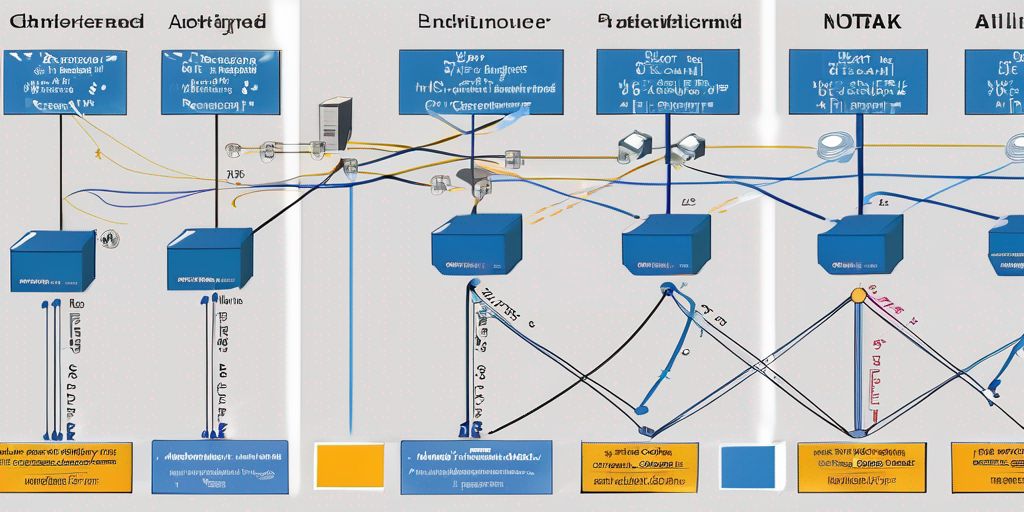The integration of Operational Support Systems (OSS) and Business Support Systems (BSS) is a crucial endeavor for telecommunication companies aiming to streamline their operations and enhance service delivery. However, this integration process is fraught with several challenges that can impede progress and affect efficiency. Understanding these challenges and exploring viable solutions is essential for a successful OSS/BSS integration. This article delves into the complexities of this integration, identifying common obstacles and discussing strategies to overcome them.
Key Takeaways
- OSS/BSS integration is vital for telecom companies to improve operational efficiency and customer service.
- Data inconsistency and duplication, legacy systems, complex processes, and lack of standardization are major integration challenges.
- Employing data mapping, API-based integration, and service-oriented architecture can address many integration issues.
- Data governance and quality management are key to ensuring the integrity and reliability of integrated systems.
- Collaboration and communication between stakeholders are crucial for navigating the complexities of OSS/BSS integration.
Understanding OSS/BSS Integration
Definition of OSS and BSS
In the context of OSS/BSS integration, OSS refers to Operations Support Systems and BSS refers to Business Support Systems. OSS encompasses the systems and processes that support the management and operation of a telecommunications network, including network inventory management, service provisioning, and fault management. BSS, on the other hand, focuses on the business aspects of a telecommunications service, such as customer management, billing, and revenue assurance.
While OSS and BSS are distinct components, their integration is crucial for the smooth functioning of a telecom operator. By integrating OSS and BSS, telecom operators can achieve a unified view of their network and business operations, enabling them to streamline processes, improve efficiency, and deliver better services to their customers.
To illustrate the importance of OSS/BSS integration, consider the following table that highlights the key differences between OSS and BSS:
| OSS | BSS |
|---|---|
| Technical | Business |
| Network-focused | Customer-focused |
| Operational | Revenue-oriented |
It is evident that the integration of OSS and BSS is essential for telecom operators to effectively manage their network and business operations, align their technical and business objectives, and ultimately succeed in the highly competitive telecommunications industry.
Importance of Integration
In the complex landscape of OSS/BSS integration, the importance of integration cannot be overstated. It plays a crucial role in ensuring the smooth and efficient operation of telecommunications companies, particularly mobile, fixed-line, and Internet operators. Without proper integration, these companies would face numerous challenges and bottlenecks that hinder their ability to deliver high-quality services to their customers. Integration allows for the seamless flow of data and processes across various OSS and BSS systems, enabling real-time visibility, accurate reporting, and streamlined operations.
Key Components of OSS/BSS Integration
In the context of OSS/BSS integration, there are several key components that play a crucial role in ensuring a successful integration process. These components include data mapping and transformation, API-based integration, service-oriented architecture, data governance and quality management, and collaboration and communication.
-
Data mapping and transformation: This component involves the mapping and transformation of data between different OSS and BSS systems. It ensures that data from various sources can be accurately and efficiently integrated into the target system.
-
API-based integration: API-based integration allows different systems to communicate and exchange data through standardized APIs. This component enables seamless integration between OSS and BSS systems, reducing the complexity and effort required for integration.
-
Service-oriented architecture: Service-oriented architecture (SOA) provides a framework for building modular and scalable systems. It allows for the integration of different services and components, enabling flexibility and reusability.
-
Data governance and quality management: Data governance and quality management are essential for maintaining the integrity and reliability of integrated data. This component ensures that data is accurate, consistent, and compliant with relevant standards and regulations.
-
Collaboration and communication: Effective collaboration and communication between different stakeholders, including IT teams, business users, and vendors, are crucial for successful OSS/BSS integration. This component facilitates the coordination and alignment of efforts, ensuring that the integration process meets the needs and requirements of all parties involved.
Challenges in OSS/BSS Integration
Data Inconsistency and Duplication
Data inconsistency and duplication are common challenges in OSS/BSS integration. When integrating multiple systems, it is common for data to be stored in different formats or with varying levels of accuracy. This can lead to discrepancies and errors in data, making it difficult to have a single source of truth. Additionally, data duplication can occur when the same information is stored in multiple systems, leading to redundancy and inefficiency.
To address these challenges, it is important to implement data mapping and transformation processes. This involves mapping data from different systems to a common format and ensuring data integrity and accuracy. By standardizing data across systems, organizations can reduce data inconsistencies and eliminate duplication. Furthermore, implementing data governance and quality management practices can help maintain data integrity and ensure that data is accurate and reliable.
In summary, data inconsistency and duplication pose significant challenges in OSS/BSS integration. However, by implementing data mapping and transformation processes, as well as data governance and quality management practices, organizations can overcome these challenges and achieve a more streamlined and efficient integration.
Legacy Systems and Vendor Lock-in
When it comes to OSS/BSS integration, one of the common challenges is dealing with legacy systems and vendor lock-in. Legacy systems refer to the outdated technology and software that are still in use within an organization. These systems often lack the necessary flexibility and compatibility to seamlessly integrate with modern OSS/BSS solutions. As a result, organizations may find themselves locked into specific vendors and unable to easily switch or upgrade their systems.
Dealing with legacy systems and vendor lock-in requires careful planning and consideration. It is important to assess the existing systems and identify any potential roadblocks to integration. This may involve evaluating the compatibility of the legacy systems with the new OSS/BSS solutions and determining the level of effort required for integration.
In some cases, organizations may need to invest in system upgrades or replacements to overcome the challenges posed by legacy systems. This can involve migrating data and functionalities from the legacy systems to the new OSS/BSS solutions. It is crucial to ensure that the migration process is well-managed and that data integrity is maintained throughout the transition.
Additionally, organizations should also consider the long-term implications of vendor lock-in. This includes evaluating the vendor’s roadmap, support capabilities, and the potential for future integration with other systems. By carefully considering these factors, organizations can mitigate the risks associated with vendor lock-in and ensure a more seamless OSS/BSS integration.
Complexity of Business Processes
The integration of OSS and BSS systems can introduce complexity to business processes. Business processes are the series of activities and tasks that organizations undertake to achieve their goals and objectives. In the context of OSS/BSS integration, business processes refer to the various operations and workflows that involve both OSS and BSS systems.
Managing the complexity of business processes is crucial for successful OSS/BSS integration. It requires a deep understanding of the interdependencies between different processes and systems, as well as the ability to streamline and optimize these processes. By aligning and harmonizing business processes, organizations can improve efficiency, reduce errors, and enhance overall performance.
To effectively navigate the complexity of business processes in OSS/BSS integration, organizations can consider the following strategies:
- Process mapping and analysis: This involves documenting and analyzing existing business processes to identify areas of improvement and potential bottlenecks. By visualizing the flow of activities and data across systems, organizations can identify opportunities for optimization and automation.
- Standardization and simplification: Standardizing and simplifying business processes can help reduce complexity and improve interoperability between OSS and BSS systems. This includes defining common data formats, naming conventions, and workflow standards.
- Change management: Implementing changes to business processes requires effective change management strategies. This involves communicating changes to stakeholders, providing training and support, and monitoring the impact of changes on operations.
By adopting these strategies, organizations can overcome the complexity of business processes in OSS/BSS integration and achieve seamless interoperability between OSS and BSS systems.
Lack of Standardization
One of the common challenges in OSS/BSS integration is the lack of standardization. The absence of standardized processes, protocols, and data formats makes it difficult to seamlessly integrate different OSS and BSS systems. This lack of standardization leads to data inconsistencies, interoperability issues, and increased complexity in managing and maintaining the integrated systems.
To address this challenge, organizations can implement a set of best practices and guidelines for standardizing their OSS/BSS integration processes. This includes defining common data models, establishing standardized APIs, and adopting industry-wide standards such as TM Forum’s Frameworx. By standardizing the integration approach, organizations can ensure smoother data exchange, reduce complexity, and improve interoperability between different OSS and BSS systems.
Solutions for OSS/BSS Integration
Data Mapping and Transformation
Data mapping and transformation play a crucial role in the integration of OSS and BSS systems. Data mapping involves defining the relationships between data elements in different systems, ensuring that data can be accurately exchanged and synchronized between them. This process requires a deep understanding of the data structures and formats used by each system, as well as the business rules and logic that govern the data. Data transformation involves converting data from one format to another, ensuring that it is compatible and usable by the receiving system.
Data mapping and transformation can be a complex and time-consuming task, especially when dealing with large volumes of data and multiple systems. It requires careful planning, analysis, and coordination to ensure that the integration process is successful and the data is accurately mapped and transformed.
To facilitate the data mapping and transformation process, organizations can use various tools and techniques. These include data integration platforms, ETL (Extract, Transform, Load) tools, and data mapping and transformation frameworks. These tools provide functionalities for mapping data elements, defining transformation rules, and automating the data exchange process.
In addition to technical considerations, organizations should also consider the impact of data mapping and transformation on their business processes and workflows. It is important to ensure that the integration of OSS and BSS systems does not disrupt or hinder existing operations. Proper testing and validation should be conducted to verify the accuracy and integrity of the mapped and transformed data.
API-based Integration
API-based integration is a crucial aspect of OSS/BSS integration that enables seamless communication and data exchange between different systems and applications. It involves the use of application programming interfaces (APIs) to connect and integrate various components of the OSS and BSS architecture.
API-based integration offers several advantages, including improved interoperability, flexibility, and scalability. It allows for the efficient exchange of data and information, enabling real-time updates and synchronization across systems. This integration approach also facilitates the development of innovative services and applications by leveraging the capabilities of different systems.
To implement API-based integration successfully, organizations need to ensure the availability and reliability of APIs, establish secure authentication and authorization mechanisms, and adhere to industry standards and best practices. Additionally, proper documentation and developer support are essential to enable seamless integration and collaboration between different stakeholders.
Service-Oriented Architecture
Service-Oriented Architecture (SOA) is a design approach that enables the integration of different software systems and services within an organization. It allows for the creation of loosely coupled and reusable components, known as services, which can be accessed and combined to fulfill specific business requirements. SOA promotes modularity, flexibility, and interoperability, making it a popular choice for OSS/BSS integration in the telecom industry.
Data Governance and Quality Management
In the context of OSS/BSS integration, data governance and quality management play a crucial role in ensuring the accuracy, consistency, and reliability of data across various systems and processes.
Data governance involves establishing policies, procedures, and controls to manage and protect data assets. It encompasses defining data ownership, roles, and responsibilities, as well as implementing data quality standards and guidelines. By implementing robust data governance practices, organizations can ensure that data is accurate, complete, and up-to-date, enabling better decision-making and operational efficiency.
Quality management, on the other hand, focuses on maintaining the quality of data throughout its lifecycle. This includes data profiling, cleansing, validation, and enrichment. By implementing data quality management processes, organizations can identify and rectify data inconsistencies, errors, and duplicates, ensuring that the integrated OSS/BSS systems operate on reliable and trustworthy data.
To effectively manage data governance and quality, organizations can consider the following strategies:
- Establish a data governance framework that defines roles, responsibilities, and processes for data management.
- Implement data quality monitoring and reporting mechanisms to identify and address data issues in a timely manner.
- Conduct regular data audits and assessments to ensure compliance with data governance policies and standards.
- Foster a culture of data stewardship and accountability across the organization.
Tip: It is important to involve stakeholders from different departments and functions in the data governance and quality management processes to ensure a holistic and collaborative approach.
Collaboration and Communication
Collaboration and communication play a crucial role in the successful integration of OSS and BSS systems. In order to navigate the complexities of integration, it is essential for all stakeholders to work together effectively. This includes collaboration between different departments within an organization, as well as communication with external vendors and partners.
One important aspect of collaboration is the sharing of knowledge and expertise. By pooling resources and sharing insights, organizations can leverage the collective knowledge of their teams to find innovative solutions to integration challenges. This can involve regular meetings, workshops, and brainstorming sessions to foster collaboration and encourage the exchange of ideas.
Effective communication is also key to ensuring a smooth integration process. Clear and open communication channels help to prevent misunderstandings and ensure that all parties are aligned on project goals and timelines. Regular updates and progress reports can help to keep everyone informed and address any issues or concerns in a timely manner.
In addition, establishing clear roles and responsibilities is essential for effective collaboration and communication. By clearly defining the responsibilities of each team member and ensuring that everyone understands their role in the integration process, organizations can minimize confusion and streamline decision-making.
Overall, collaboration and communication are vital for successful OSS/BSS integration. By working together and maintaining open lines of communication, organizations can overcome challenges and achieve seamless integration of their operational support and business support systems.
Solutions for OSS/BSS Integration is a crucial aspect of any modern business. At METAVSHN, we understand the challenges that come with integrating OSS/BSS systems and we have developed a comprehensive platform to address these challenges. Our platform offers seamless integration, real-time data synchronization, and advanced analytics capabilities. By adopting the METAVSHN Platform, businesses can streamline their operations, improve efficiency, and gain a competitive edge in the market. Visit our website to learn more about how our solutions can benefit your business.
Conclusion
In summary, the integration of OSS/BSS systems presents a multifaceted challenge for telecommunications companies. However, by understanding the common obstacles and implementing strategic solutions, organizations can effectively navigate these complexities. Emphasizing the importance of interoperability and the adoption of agile methodologies, businesses can create a more seamless and efficient operational environment. It is essential to recognize that while the path to integration is seldom straightforward, the rewards of a well-executed OSS/BSS integration can be substantial, leading to improved customer satisfaction, reduced operational costs, and enhanced service delivery.





